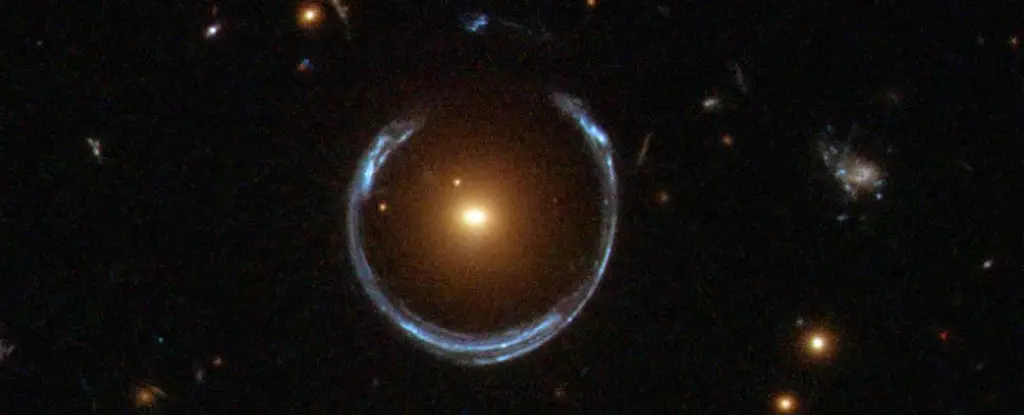In a groundbreaking study released recently, astronomers have shed light on a fascinating celestial phenomenon known as the Cosmic Horseshoe, a gravitationally lensed structure located approximately 5.5 billion light-years from Earth. This system comprises multiple galaxies, with a foreground galaxy serving as a lens that magnificently distorts and amplifies the light emitted from a more distant background galaxy. Such gravitational lensing is not just a visual spectacle; it serves as a tool for astrophysicists to delve into the mysteries of the universe. Central to this research is an astonishingly large Ultra-Massive Black Hole (UMBH) embedded within the foreground galaxy, identified as LRG 3-757, with a mass equivalent to a staggering 36 billion solar masses.
While the nomenclature for black holes evolves, the term “Ultra-Massive Black Hole” refers specifically to supermassive black holes exceeding 5 billion solar masses. Despite the absence of a formal definition, the term has gained traction within the astrophysical community to differentiate these colossal entities from smaller counterparts. Throughout the past decades, the presence of supermassive black holes in galaxies has become increasingly recognized, leading researchers to conclude that the largest among them deserve a unique designation due to their extraordinary masses.
The revelations about the UMBH at the heart of LRG 3-757 were disseminated in a research paper authored by Carlos Melo-Carneiro and colleagues from the Instituto de Física, Universidade Federal do Rio Grande do Sul in Brazil. This study enriches our understanding of black holes and their relationship with galaxies, deepening the cosmic narrative we have been piecing together over the years.
The discovery of gravitationally lensed structures roots back to a significant paradigm shift in physics initiated by Albert Einstein in the late 19th and early 20th centuries. Einstein’s theory of relativity reshaped our concept of space and time, illustrating how massive objects can warp the very fabric of spacetime itself. One of Einstein’s seminal predictions was gravitational lensing, indicating that massive objects could distort light from objects behind them. Although Einstein himself did not witness the empirical evidence of this phenomenon, thousands of such instances have now been cataloged, providing astronomers with a wealth of data to analyze.
The foreground galaxy within the Cosmic Horseshoe—LRG 3-757—has a mass 100 times greater than that of our Milky Way. This immense mass indicates a foundational connection between galaxies and their central black holes. The research highlights the established correlation known as the MBH-sigmae relation, which posits that a black hole’s mass correlates with the velocity dispersion of stars in the galaxy’s bulge. Observations indicate that as black hole mass increases, so too does the randomness of star movement within the host galaxy.
However, the UMBH in LRG 3-757 appears to reject this correlation, being far more massive than what the MBH-sigmae relationship would predict for such a galaxy. The authors of the study note that LRG 3-757 sits about 1.5 sigma above the expected relation. This bears significant implications for our understanding of galaxy evolution, suggesting that in extremely massive galaxies, the growth of supermassive black holes may be governed by different mechanisms than those that apply to less massive galaxies.
The deviations observed raise questions about the evolutionary history shared between UMBHs and their host galaxies. The authors propose several hypotheses: past mergers may have affected the velocity dispersion of stars, possibly removing some stars from the galaxy. Alternatively, interactions during these mergers could have led to a phenomenon known as “scouring,” whereby stars are ejected from the vicinity of the black hole without substantially altering its mass. Another theory posits that black holes could exhibit feedback mechanisms affecting the overall structure of their host galaxies during periods of active growth.
The findings from the Cosmic Horseshoe are just the beginning. Future telescopes, such as the upcoming Euclid mission, are expected to identify hundreds of thousands of gravitational lenses, providing astronomers with a rich dataset to further explore such anomalies in the MBH-sigmae relation. The Extremely Large Telescope will also enhance our understanding by enabling detailed studies of stellar dynamics in these grand systems.
As we stand on the threshold of a new era in cosmic discovery, the implications of understanding UMBHs extend beyond mere curiosity; they challenge us to rethink how we perceive the universe and the connections within it. The ongoing exploration of the cosmos will undoubtedly lead to more revelations that may dramatically reshape our understanding of galactic evolution and the fundamental forces at play in shaping the universe. Such discoveries not only contribute to our scientific knowledge but also ignite the human imagination, drawing us further into the remarkable depths of space.

